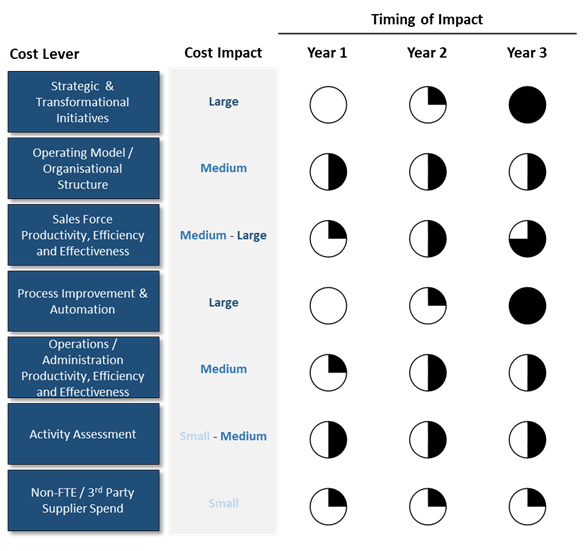CONTEXT
Our client, a major Australian/NZ insurance and wealth management company, was facing serious strategic and financial challenges and needed to undertake a transformation of its business. CACE Partners was engaged to assist the client in achieving a step change in its cost structure whilst at the same time nearly doubling revenue, increasing adviser and customer satisfaction and improving employee engagement. Our first engagement of three years involved the design and implementation of a 3 year strategic cost reduction program to reduce absolute costs by 25%. Our second engagement of eighteen months involved the design and implementation of a strategic cost reduction program to reduce absolute costs by a further 10% over 2 years.
INSIGHTS / APPROACH
For both engagements, a joint CACE Partners/client team adopted a structured strategic cost reduction approach across all areas of the client’s Australian and NZ operations.
The key steps in the adopted approach included:
- the development of a market competitive cost-to-income ratio required over each of the following three years in the first engagement and two years in the second engagement
- the translation of the cost-to-income ratios to absolute dollar cost targets required over each of the following three years for the first engagement and two years for the second engagement, based on forecast income levels and target returns on equity
- the application of a structured cost reduction methodology across the entire organisation to identify initiatives to achieve the required absolute cost structure. The methodology focused on seven key work streams
- Strategic/Transformational opportunities
- Operating Model/Organisation structure optimisation
- Sales force productivity and efficiency improvement
- End-to-end process improvement & automation
- Operations consolidation & efficiency improvement
- Elimination of low/no value activities across the organisation
- Non-FTE/3rd party spend reduction
- the development of implementation plans and the setup of a programme management office to drive implementation of initiatives and track key benefits
RESULTS
The initial three-year programme achieved a reduction of over 25% over the three-year time horizon. The succeeding programme achieved a further reduction of nearly 15% over the two-year time horizon.
The achievement of the cost reductions utilised all seven levers. In the early years of the programme, the reduction in costs were achieved through low/no-IT initiatives, principally through non-FTE reductions, support function consolidation between Australia and NZ, elimination of low/no value activities, elimination of a layer of middle management and the sale of non-core assets. The later year cost reductions were achieved largely through the automation and redesign of key end-to-end processes, the outsourcing of several operational activities to lower cost locations and the outsourcing of several IT activities to a global third party.

